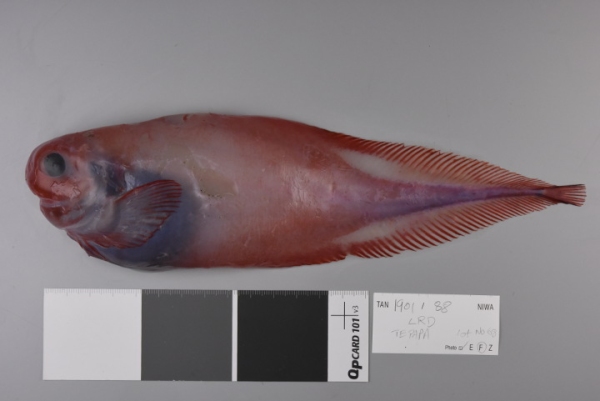9 February 2019. By Voyage Leader Dr Richard O'Driscoll.
Day 32 of the Ross Sea Environment and Ecosystem Voyage 2019 on RV Tangaroa and we are heading north!
One of the biggest challenges with any Antarctic voyage is dealing with ice—ice onboard makes it hard to work and ice in the water stops you getting where you want to go! After having a relatively ice-free voyage, we were reminded we were in Antarctica last Sunday night when we ran into bands of sea ice at about 165 degrees west.
This prevented us reaching our final three random sites within the General Protection Zone (GPZ) of the Ross Sea Marine Protected Area. But we still managed to sample at 30 of our 33 planned locations to complete a successful survey of seabed habitats and fish on the Ross Sea slope at 600-1500 m depths.
A total catch of 1056.5 kg was taken during the slope survey. This was made up of 89 species or species groups, including 42 fish species. The main species in the catch by weight were rattails (grenadiers), jellyfish, toothfish, icefish, glacial squid, violet cod, and silverfish. Several rare on unusual fish specimens were caught.
These included whalefish, snailfish, and big-scale fish, which were among the many specimens preserved for further identification. More than 1500 individual fish were measured, and samples were taken for genetic work, and for stable isotope and stomach content analysis. Otoliths (fish ear bones) were also collected for ageing. Four Antarctic toothfish were caught, of which three large specimens (estimated weights from 30-40 kg) were tagged and released alive. Seeing and handling these large toothfish is always a highlight!
Having been turned back by the ice, we made a quick run south onto the Ross Sea shelf on Monday morning, where we carried out a camera (DTIS) transect, as well as water sampling and plankton tows. There was evidence of recent high productivity in this region, with elevated chlorophyll concentrations in the water, and the sea-bed covered by a green mat of dead algae. We made it as far as 76 degrees 30 minutes south. This was the second furtherest south that Tangaroa has ever been (we reached 76 48’ S in 2008). While it was tempting to push the 18 miles needed to break the record, science objectives prevailed and, after a quick group photo, we started to head north.
Our plan was to transit south-to-north across the Ross Gyre. The Ross Gyre is a large clockwise current system that (among other things) is thought to be the “conveyor” by which toothfish larvae are transported from their winter spawning grounds on the Pacific Antarctic Ridge back onto the Ross Sea shelf. The Ross Gyre has been rarely sampled because it is usually under ice. Even this year, we ran into ice and had to go back west before heading north.
The cameras were out though as we spotted whales and penguins as we travelled along the ice edge. We even saw an emperor penguin—maybe a relation of Happy Feet who was a passenger on Tangaroa in 2011?
The Ross Gyre itself was disappointing—at least to those involved in the objective to study midwater fish. After weeks of looking at echosounders to try and identify and quantify the krill and small fish that live in the Ross Sea, Pablo Escobar-Flores and his team were looking forward to seeing what was present in the oceanic waters of the Gyre. The answer was disappointingly little—and shift after shift was spent staring at blank white screens. Acoustic targets or ‘marks’ only started to appear again as we approached the seamount features further north, and (unsurprisingly) this was where we started to see whales again too.
We reached Scott C Seamount on Thursday afternoon. This was the location of the passive acoustic (whale listening post) mooring that had failed to release and come to the surface on our way south on 16 January. Overnight we had four attempts to ‘fish’ this mooring up using a grapnel attached to the trawl wire. Although we were able to hook onto it a couple of times, we were ultimately unsuccessful in getting it back to the surface. In over 1000 metres of water this was always going to be a difficult exercise, and it is testament to the skill of the Tangaroa officers that we came as close as we did. Although frustrating, we are satisfied that we gave it our best shot. We know exactly where the mooring is and will come better equipped for its recovery in 2021.
Today (Saturday) our course is set for Wellington and we are on our homeward stretch. We have two more days of science activities planned before we leave the CCAMLR zone at 60 south. After that it will be full-on tidying, cleaning, and report writing.
We are due back in Wellington on the morning of Saturday 16 February.




